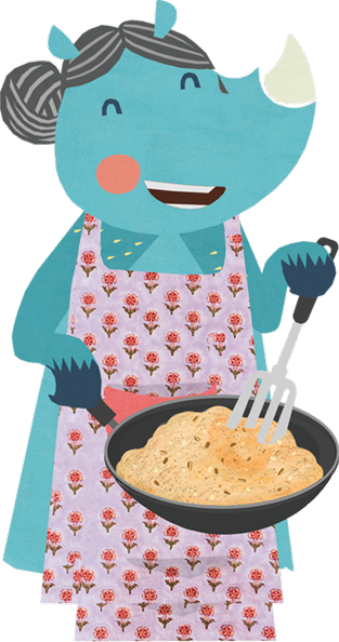Pulses are a nutritious, versatile, and affordable group of foods! They’re packed with protein, iron, fiber, and other key nutrients that babies need.
The best part is that eating pulses and lentils can be very enjoyable! The wide variety of recipes available is a celebration of India’s diversity (e.g., how pulses are cooked in Punjab will differ from how they’re cooked in Maharashtra).
Pulses can be introduced to your baby’s diet from 6 months onward.
Why Introduce Pulses to Your Baby's Diet?

1) High in nutrition: Pulses are rich in essential nutrients, vitamins, and minerals that can support your baby’s overall health, including magnesium, potassium, Vitamin K, thiamin, phosphorus, zinc, folate, antioxidants, and more.
2) Great source of iron: Pulses are a great source of iron. But the iron (non-heme iron) is not easily absorbed in the body. Therefore, it’s a good idea to pair pulses with Vitamin-C rich foods like tomatoes and lemon to improve iron absorption.
3) Taste and texture exploration: Introducing pulses exposes babies to different tastes, textures, and flavors, expanding their palate and encouraging acceptance of a wide variety of foods.
4) Good source of fiber: Pulses are also good sources of soluble and insoluble fiber.
5) Common in Indian cooking: Pulses are integral to Indian diets. Dishes made from lentils (dal), kidney beans (rajma), or chickpea (kabuli chana/chole) are popular and delicious go-to meals in our homes. It’s good if your baby starts enjoying traditional Indian foods, and can enjoy what the rest of the family is eating at dinner time!
You Can Add These Pulses/Lentils to Your Baby’s Solid Foods

- Bengal gram, roasted flour, dal, whole (chana)
- Black gram, roasted flour, dal, whole (urad)
- Green gram, roasted flour, dal, whole (moong)
- Red gram, roasted flour, dal, whole (toor)
- Horse gram (kulithi)
- Red lentil, whole (masoor)
- Black eyed beans, dal (chawli)
- Lentils, roasted flour, brown, yellow (dals)
- Peas, dry, roasted, fresh green (matar)
- Cow pea, brown & white (lobiya)
- Kidney beans, red, brown (rajma)
- Soya bean, brown, white
- Field beans, brown, black (vaal)
- Moth beans (matki)
- Rice bean (naurangi dal)
- Edamame
The Right Way to Prepare Pulses for Your Baby
Each baby is unique, and their acceptance of different foods can vary based on their individual gross motor skills, fine motor skills, and oral motor development. Therefore, the timeline for introducing new foods may differ for each baby! So don’t stress if your little one is yet to accept or enjoy pulses/lentils.
Now there are 3 methods to consume pulses, and you can use whichever suits your cooking preference and convenience.
Method 1: SOAK them:

Pulses can be gas-inducing. That’s why, it’s common to soak the pulses or lentils at least 6-12 hours before cooking or consuming. Soaking reduces the gas-producing fibers, making pulses easier to digest once cooked.
Overnight soaking of dried pulses in water, and then boiling or pressure cooking them, can inactivate most lectins (a type of anti-nutrient present in pulses/legumes).
Steps for Soaking & Cooking
1) Place the pulses and lentils in a bowl and cover and soak them with water overnight or at least 12 hours. Pulses can expand while soaking, ensure you choose a bowl that is big enough.
2) The next day, just before you’re about to cook the soaked pulses, drain and rinse them thoroughly (discard the water it was soaked in). Cook according to your preferred method.
Method 2: SPROUT them

Another method to consume pulses is by sprouting them. Sprouting pulses like mung and Moth bean (matki) reduces the anti-nutrients (which cause gas) and increases the amount of iron and fiber, allowing for easy absorption into the body.
Steps for Sprouting & Cooking
1) Immerse the dals/pulses/legumes completely in water for at least 12 to 15 hours. You will know it's adequately soaked when you take a bite and it feels good to eat as is!
2) At this stage, drain the water. Place the soaked pulses/legumes in a wet muslin cloth and sprinkle some water over the pulses.
3) Place the muslin cloth with the soaked pulses in a bowl and cover it lightly with a lid so there’s air circulation.
4) It’s important that this muslin cloth has moisture at all times, so when you notice the muslin cloth is dry, sprinkle some water on the cloth. The moisture and air will help the pulses/legumes sprout!
5) The process of sprouting will take at least 12 hours based on the size of the pulse or legume. The time may vary according to the temperature or humidity around (the process may take longer in winter than in summer).
6) Once you notice the pulses/legumes have sprouted, transfer them to a storage container and store them in the refrigerator for about a week and use them as desired.
Method 3: GRIND them

Alternatively, many people dry the pulses, roast them, and make it into flour or atta, which can then be used to make porridges.
PULSES: Age-Wise Recipes & Tips
|
6 to 8 months |
1) Pulse porridge powder: Dry roast the whole pulses, grind them, and store the powder in an airtight container. When required, take 2 to 4 tablespoons of the pulse porridge powder, mix it with hot water, and feed it to your baby. E.g., green gram porridge, Sathu porridge
2) Thick lentil vegetable soup: Prepare a hearty lentil vegetable soup by soaking the lentils overnight and cooking them in a pressure cooker with spices such as cumin powder, a small amount of grated ginger, turmeric powder, and vegetables like pumpkin or bottle gourd. Blend the mixture to a thick consistency using a blender and serve it with a dollop of ghee. E.g., curried lentil soup or thick lentil vegetable soup.
3) Khichdi: Soak the lentils overnight and cook them in a pressure cooker until they are soft. Mash them together with boiled and cooked rice and vegetables to prepare a khichdi. Add a small dollop of ghee and offer it to your baby. E.g., moong dal khichdi, masoor dal khichdi, pongal.
4) Cooked dal: Serve cooked dal on top of foods that are easy to scoop, like rice or curd. E.g., dal kadhi added on top of rice or chapati, palak dal added on top of rice or chapati, moru curry (Kerala-style curd-based curry) with dal added on top of rice or dosa, etc. |
|
9 to 11 months |
1) Continue to serve dals and pulses to your baby in an easily scoopable form, allowing them to self-feed with their hands or a preloaded spoon.
2) During this stage, when your baby enjoys picking and exploring, you can incorporate dals and lentils into their meals by making patties, fritters, or kebabs. These preparations hold their shape well and allow babies to easily grab and hold them in their hands for self-feeding. You can also add curd, yogurt, or a mint dip on top of the patty, fritters, kebab, or chilla (a type of dosa-like crepe). E.g., green peas fritters, ragda pattice, or moong dal chilla with curd.
3) You can also serve whole lentils like rajma or chole, which can be slightly squished or flattened before serving. E.g., rajma chawal: flatten the rajma with your hand or spoon, but make sure it’s not completely mashed, and serve it over soft cooked rice or soft pieces of chapati, which your baby can scoop up and eat with their hands. E.g., chole chawal, bisi bele bhath (popular rice dish of Karnataka), sambhar rice, rasam rice, chana dal pulao with vegetables and curd, moru curry or mor kozhambu (South-Indian style buttermilk/curd-based curry) added on top of it.
4) Offer a variety of flavors and textures by adding appropriate seasonings to the cooked dals, curries, or gravies. E.g., moong dal idli with sambhar, adai (South-Indian lentil dosa) with cooked vegetable gravy, dal dhokli (Gujarati dish with tur dal and wheat). |
|
12 to 24 months |
1) Dals and pulses can be served as mentioned in the previous age group.
2) At this age, babies enjoy picking up tiny pulses and dals with their hands and eating them. So it’s a good idea to offer cooked pulses and lentils that retain their shape even after cooking it. E.g., well-cooked sprouts curry with rice or chapati, dal makhani with easily scoopable dals, chawli curry with chapati, cow peas sabji with chapatis, usal, matki, etc.
3) Continue exploring by gradually adding more spices and herbs to dals and pulses to introduce more variety to your baby’s meals. |

















